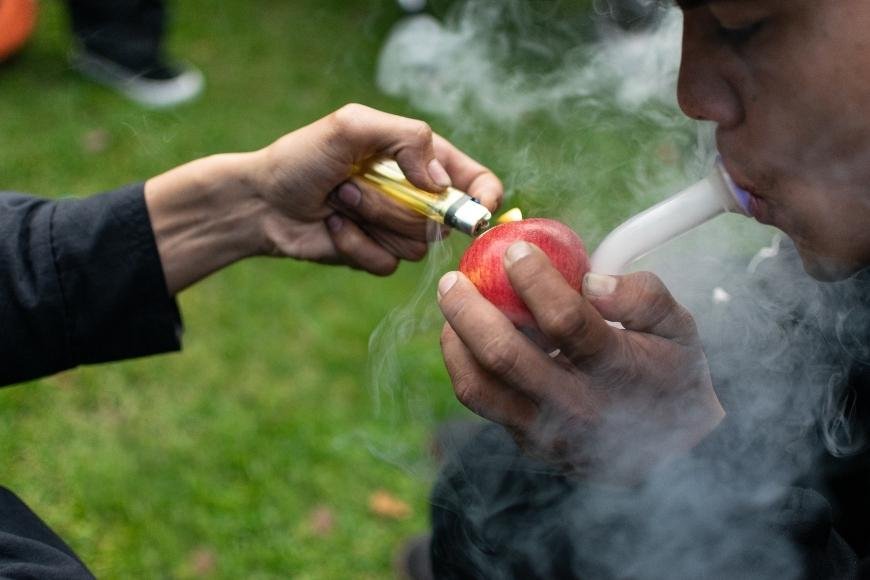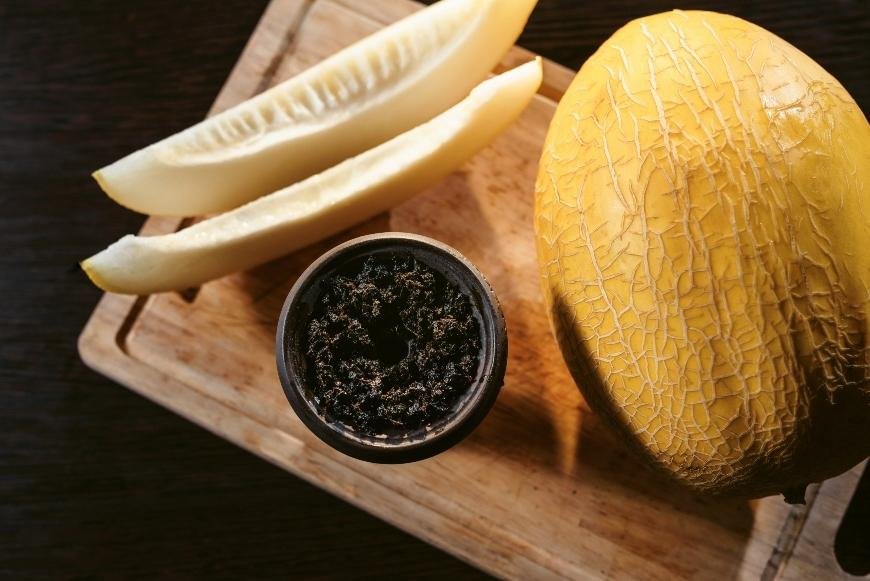The Best Fruits and Vegetables for Making Bongs and Pipes
Discover the best fruits and vegetables for making bongs and pipes, along with crafting instructions, safety precautions, and enhancing your smoking experience.

When it comes to the best fruits and vegetables for making bongs and pipes, creativity knows no bounds. In this blog post, we will investigate the advantages of utilizing these natural materials as a substitute for customary glass or metal smoking gadgets and how to make them securely and productively. From their eco-friendly nature to their unique flavor-enhancing properties, there's a lot to appreciate about fruit cannabis pipes and vegetable bongs.
We'll delve into commonly used produce items for crafting your own makeshift pipe or water pipe, along with detailed instructions on how to create them safely and effectively. Furthermore, we'll discuss ways in which you can enhance your smoking experience by incorporating certain techniques when using these homemade creations.
Lastly, given the temporary nature of fruit and vegetable pipes, we will provide some considerations before embarking on this innovative journey into creating the best fruits and vegetables for making bongs and pipes.
Table of Contents:
- Benefits of Using Fruits and Vegetables for Bongs and Pipes
- Commonly Used Produce Items
- Safety Precautions
- Enhancing the Smoking Experience
- Temporary Nature of Homemade Creations
- Considerations Before Crafting
- FAQs in Relation to The Best Fruits and Vegetables for Making Bongs and Pipes
- Conclusion
Benefits of Using Fruits and Vegetables for Bongs and Pipes
Using fruits and vegetables as materials to create homemade bongs and pipes is a fun and experimental approach that offers several benefits. For those who enjoy novelty experiences, crafting smoking devices from produce items can be an exciting way to explore alternative methods.
- Eco-friendly: Unlike traditional glass or acrylic pieces, fruit and vegetable-based smoking devices are biodegradable, reducing waste in the environment. After use, they can simply be composted or discarded responsibly.
- Natural flavors: Many fruits impart their natural flavors into the smoke when used as a pipe or bong material. This adds an interesting twist to your smoking experience by providing subtle fruity notes that complement various strains of cannabis.
- Creativity boost: Crafting unique designs with different types of produce allows you to exercise your creativity while enjoying recreational substances. This includes apple pipe and apple bowl, banana pipe, pumpkin bong, potato pipe, and squash pipe.
- Affordability: Most fruits and vegetables are relatively inexpensive compared to purchasing premade glass or acrylic pieces. This makes them an accessible option for individuals on a budget.
Please note that while these homemade creations may not provide the durability and longevity of traditional devices, they offer a unique experience for those seeking novelty in their smoking sessions. Always remember to practice responsible consumption habits when using any type of substance.

Commonly Used Produce Items
When it comes to crafting homemade smoking devices, certain fruits and vegetables stand out due to their unique properties. Here are some popular choices:
- Apples: A classic choice for making pipes, apples have a firm texture that makes them easy to carve. Their natural moisture also helps cool the smoke.
- Pineapples: With their large size and hollow core, pineapples make excellent bongs. The fruit's sweet aroma adds an enjoyable twist to your smoking experience. Check out this guide on how to make a pineapple bong.
- Watermelons: Like pineapples, watermelons can be used as bongs thanks to their size and hollow interior. They're also great for summer gatherings or outdoor sessions.
- Pumpkins: Seasonal favorites like pumpkins offer another option for creating homemade bongs with a festive touch during Halloween or Thanksgiving celebrations.
- Zucchinis: Long and sturdy zucchinis work well as makeshift pipes when you need something quick and simple.
In addition to these popular options, many other fruits and vegetables can be repurposed into tropical smoking apparatus with a little creativity. Don't hesitate to experiment with different produce items such as oranges, cucumbers, or even bell peppers - just remember that freshness is key.
Selecting Your Produce Item
To ensure optimal results when crafting your homemade device from fruits or vegetables, consider the following factors before making your selection:
- Freshness: Choose produce that is fresh and free of mold or decay to ensure a clean, enjoyable smoking experience.
- Size and Shape: Opt for items with the appropriate dimensions to accommodate your desired smoking apparatus design.
- Durability: Select fruits or vegetables with firm textures that can withstand carving and handling without falling apart.
Bear in mind that some experimentation may be necessary to find the perfect fruit or vegetable for your homemade bong or pipe. Have fun exploring different options.
Crafting Instructions
Creating a homemade bong or pipe from fruits and vegetables is an enjoyable and straightforward process. Here are some simple steps to follow:
- Select your produce item: Choose a fruit or vegetable that has the desired shape, size, and texture for your smoking device. Some popular options include apples, oranges, pineapples, watermelons, pumpkins, and zucchinis.
- Prepare the produce: Wash your chosen item thoroughly to remove any dirt or pesticides. If necessary, cut off any unwanted parts (such as stems) to create a stable base for your smoking apparatus.
- Create the bowl: Carve out a small indentation on one side of the fruit or vegetable using a knife or spoon. This will serve as the bowl where you'll place your cannabis. Ensure it's deep enough to hold the material but not too deep that it punctures through entirely.
- Add airflow: Use a skewer or pen to poke a carb hole in another part of the produce connecting with the carved-out bowl area internally. This creates an air path for smoke inhalation during use.
- Fashion mouthpiece & downstem (if applicable): For pipes - carve out another hole opposite from step four which will act as both mouthpiece & downstem; For bongs - make two separate holes: one near the top acting as the mouthpiece while the other connects with the hollowed chamber inside serving as the downstem insertion point (watermelon bongs are a great example).
- Assemble your smoking device: For bongs, insert a downstem (can be made from pen tubes or straws) into the designated hole. Add water to create filtration if desired.
Note that these homemade creations may not last as long as traditional glass or acrylic devices but offer an entertaining and novel experience for those seeking creativity in their smoking sessions. To prevent small particles from entering your mouth, ensure that you clean your fruit cannabis pipes or vegetable bongs thoroughly before use.
Safety Precautions
When crafting homemade smoking devices from fruits and vegetables, it's essential to prioritize safety. Keep in mind the following precautions to ensure a safe and enjoyable experience:
- Use clean materials: Always wash your chosen produce thoroughly before carving or hollowing out any parts. Before carving or hollowing out any parts, be sure to clean the chosen produce thoroughly in order to eliminate dirt, pesticides and other contaminants.
- Avoid toxic substances: Some fruits and vegetables have naturally occurring toxins or allergens that can cause adverse reactions when smoked. For example, avoid using mango skins as they contain urushiol oil, which is also found in poison ivy. Do some research beforehand to ensure your chosen produce is safe for use.
- Select appropriate tools: Use sharp knives or carving tools specifically designed for cutting fruits and vegetables to minimize injury risk. Additionally, consider wearing gloves while working with certain items like pineapples due to their acidic nature.
- Create proper airflow: Ensure there are adequate air passages within your homemade bong or pipe by creating a hole large enough for smoke inhalation but small enough not to compromise structural integrity.
- Maintain hygiene during use: Since these creations are temporary in nature, bacteria can accumulate quickly if not properly cared for. Clean all components after each session with warm water and mild soap then discard them once they become too worn or dirty.
Enhancing the Smoking Experience
Using fruits and vegetables for crafting homemade bongs and pipes can provide a unique smoking experience. To make the most of your DIY creations, consider these tips:
- Add ice or cold water: Adding ice cubes or cold water to your fruit or vegetable bong will help cool down the smoke, providing smooth hits. This is especially beneficial when using produce with larger chambers like watermelons.
- Mint leaves: Incorporate fresh mint leaves into your pipe's bowl piece to add an invigorating flavor to your smoke session. Mint not only enhances taste but also provides a refreshing sensation.
- Natural filters: Use organic materials such as apple slices or lemon peels as natural filters in your homemade pipes. These can help filter out unwanted particles while adding subtle flavors to the smoke.
- Cleanliness matters: Ensure that you thoroughly clean and dry all components of your homemade smoking device before use. Proper hygiene is essential for maintaining optimal performance and preventing any potential health risks associated with moldy or contaminated produce.
Besides enhancing flavor, experimenting with different fruits and vegetables allows you to discover new textures, shapes, and sizes that may suit individual preferences better than traditional glass or acrylic devices. For instance, some people might prefer softer materials like bananas over harder ones like carrots due to their ease of carving.
Temporary Nature of Homemade Creations
Though constructing home-made bongs and pipes from fruits and veg may be a great time, it is important to remember that these are not long lasting. Unlike traditional glass or acrylic devices, fruit and vegetable smoking apparatuses will not last long due to their organic nature.
Due to their short lifespan, it's important to ensure that your fruits and vegetables are fresh before carving them into a makeshift smoking device. This is especially true once you've carved into them for your makeshift smoking device. As such, it's crucial to store your produce properly before use, ensuring that they're fresh when you decide to craft your bong or pipe.
- Use promptly: After creating your homemade smoking device, use it within a day or two at most. The longer the fruit or vegetable sits after being carved, the higher the risk of bacteria growth.
- Clean thoroughly: Make sure you clean both the exterior and interior of the chosen produce item before using it as a smoking device. This helps remove any dirt or contaminants present on its surface.
- Avoid reuse: Due to potential bacterial growth over time in used items, avoid reusing fruits and vegetables for multiple sessions - always create new ones instead.
Beyond hygiene concerns related to using perishable materials like fruits and vegetables for making bongs and pipes, Azarius suggests considering other factors such as flavor changes during consumption since different produce items may alter taste profiles depending on their natural flavors.

Considerations Before Crafting
Before taking the plunge into creating homemade smoking devices with fruit and veg, it's essential to consider a few elements that will make for a safe and enjoyable experience. The cleanliness and freshness of your chosen produce items play a significant role in the overall quality of your smoking apparatus.
Selecting Fresh Produce
To begin with, always choose fresh fruits or vegetables for crafting your bong or pipe. Overripe or rotting produce can harbor harmful bacteria, which may pose health risks when smoked. Opt for firm, unblemished items without any signs of mold or decay.
Cleaning Your Chosen Items
Prioritize hygiene by thoroughly washing your selected fruits and vegetables before transforming them into smoking devices. Use clean water to remove dirt, pesticides, or other contaminants from their surfaces. You can also use natural cleaning solutions, such as vinegar-water mixtures if desired.
Avoiding Toxic Materials
- When selecting materials for creating mouthpieces or downstems (e.g., pen tubes), avoid using plastic components that might release toxic fumes when heated.
- Instead, opt for safer alternatives like stainless steel straws or glass tubing whenever possible.
Incorporating these considerations into your creative process will help you craft temporary smoking devices that are both fun to use and mindful of safety precautions - ensuring an enjoyable experience while experimenting with fruits and vegetables as bongs and pipes.
FAQs in Relation to The Best Fruits and Vegetables for Making Bongs and Pipes
What Fruits Can Be Turned into Bongs?
Various fruits can be used to create homemade bongs, including apples, watermelons, pineapples, and pumpkins. Each fruit offers a unique smoking experience due to its size and flavor profile. It's essential to choose a sturdy fruit with enough space for the bowl and downstem.
What Fruit Can I Make a Pipe From?
An apple is one of the most popular choices for making a pipe because it's easy to carve and provides an enjoyable taste when smoked. Other options include pears, cucumbers, carrots, or potatoes. Ensure that your chosen produce item is firm enough not to collapse during use.
What Fruits Smoke Well?
Fruits that provide pleasant flavors while smoking include apples, pears, strawberries (for small pipes), peaches (when dried), cherries (with pits removed), plums (dried or fresh), nectarines (ripe but firm), and apricots (fresh). These fruits have distinctive tastes that enhance the overall smoking experience.
Can You Make a Pipe Out of a Pear?
Absolutely. Pears are suitable for creating pipes as they're relatively firm yet easy to carve. To craft your own pear pipe: remove the stem; poke two holes intersecting at 90 degrees in its place; one hole should go halfway through horizontally while another goes vertically downwards, then attach your preferred mouthpiece on top.
Conclusion
Using fruits and vegetables to create smoking devices is a fun and creative way to enhance your smoking experience. Not only do they add a unique element to your smoking routine, but they can also provide flavors that traditional glass or metal pieces cannot. Some popular produce items used for this purpose include apples, watermelons, carrots, and potatoes.
When crafting your homemade smoking device, it's important to take safety precautions such as using a sharp knife or drill carefully and avoiding any toxic materials. While these creations may be temporary, they can still offer an enjoyable smoking experience with added benefits.






































































































































